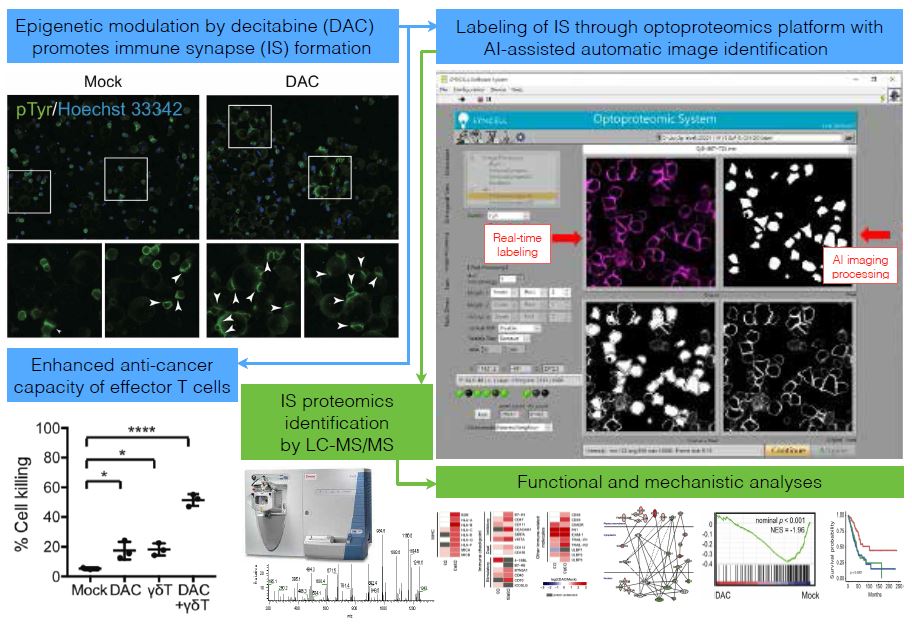以超高解析顯微鏡與光蛋白質體學探討免疫突觸於T細胞抗腫瘤免疫之角色
Superresolution imaging and optoproteomics of immunological synapses to decipher their role in T cell-based antitumor immunity
 Immune synapse is a structure formed at the interface between effector T cells and target cells, such as antigen-presenting cells (APC), virus-infected cells and cancer. Much ongoing research has focused on elucidating structural and functional properties of immune synapses and how they regulate T cell activation. The research on immune synapse is particularly important in the field of oncology as immune-based therapy has proven efficacious in various cancer types, including lung cancer. Nevertheless, comprehensive characterization of diverse immune synapses formed by target cells and different classes of T cells remain elusive due to technical limitations of conventional proteomics and microscopy. In this research project, we successfully established the novel optoproteomics platform with an incorporated AI model for highthroughput automatic imaging recognition and labeling. For the immune synapse between αβ T and APC cells, we identified INPP5E as a novel immune synapse protein that interacts with CD3ζ, ZAP-70, and Lck and is required for T-cell activation cascade. For the immune synapse between lung cancer and γδ T cells, we discovered that epigenetic therapy or genetic manipulation of ICAM-1 can augment immune synapse formation and tumor lysis by γδ T cells. Our team not only developed the novel optoproteomics technique, but also delineated the structure and functional complexity of various types of immune synapses and their regulatory mechanisms, which paves way to developing new cellular immunotherapy strategies in cancer treatment.
Immune synapse is a structure formed at the interface between effector T cells and target cells, such as antigen-presenting cells (APC), virus-infected cells and cancer. Much ongoing research has focused on elucidating structural and functional properties of immune synapses and how they regulate T cell activation. The research on immune synapse is particularly important in the field of oncology as immune-based therapy has proven efficacious in various cancer types, including lung cancer. Nevertheless, comprehensive characterization of diverse immune synapses formed by target cells and different classes of T cells remain elusive due to technical limitations of conventional proteomics and microscopy. In this research project, we successfully established the novel optoproteomics platform with an incorporated AI model for highthroughput automatic imaging recognition and labeling. For the immune synapse between αβ T and APC cells, we identified INPP5E as a novel immune synapse protein that interacts with CD3ζ, ZAP-70, and Lck and is required for T-cell activation cascade. For the immune synapse between lung cancer and γδ T cells, we discovered that epigenetic therapy or genetic manipulation of ICAM-1 can augment immune synapse formation and tumor lysis by γδ T cells. Our team not only developed the novel optoproteomics technique, but also delineated the structure and functional complexity of various types of immune synapses and their regulatory mechanisms, which paves way to developing new cellular immunotherapy strategies in cancer treatment.
免疫突觸為T 細胞與標的細胞 (如抗原呈現細胞、受病毒感染之細胞與腫瘤細胞)中間形成的結構,探討免疫突觸的功能結構及其調控T 細胞活化的機轉,為癌症免疫治療領域中重要之研究主題。然而,不同T 細胞與標的細胞形成的免疫突觸不盡相同,且過去研究這些免疫突觸的結構與功能性差異,受到許多光學技術上的限制。在本計畫中我們成功的優化「光標靶儀」並開發AI 影像辨識平台,使影像擷取與標定全自動化,獲得第十七屆國家新創獎,且已成立新創公司並進駐國家生技研究園區。此外,我們的研究發現新的突觸蛋白INPP5E,存在於αβ T 細胞與抗原呈現細胞間,在Τ 細胞受刺激後,可聚集於免疫突觸處,與CD3ζ, ZAP-70, and Lck 結合,為Τ 細胞活化之訊息傳遞不可或缺的因子。另一方面,我們亦發現,γδ T 細胞與腫瘤細胞的免疫突觸可受到表觀遺傳機轉調控,藉由調節免疫突觸蛋白中之ICAM-1 與相連結之細胞骨架,可增加免疫突觸的形成,以及γδ T 細胞對腫瘤細胞之毒殺作用。因此,我們團隊不僅開發了擷取胞內蛋白之創新技術,並進一步檢視了不同Τ 細胞免疫突觸間的結構,找到調節免疫突觸訊息傳遞或穩定度的機轉,對於將來開發新穎的癌症免疫細胞療法有顯著貢獻。
